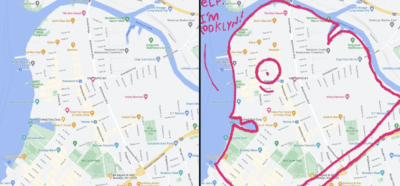Who are the people who ride electric unicycles anyway?
The scooter revolution will be electrified: Meet three New Yorkers who have embraced alternative 'micromobility' vehicles
In June of last year, the New York City Council passed legislation that officially legalized the use of electric scooters and electric bikes on the city’s streets.
Initially favored by delivery workers, personal electric vehicles (PEVs for short) have clearly been embraced by a wide swath of humanity—from students to commuters to neighborhood eccentrics. And the list of available options has ballooned beyond just e-bikes and scooters: Now there are electric skateboards, unicycles, and “onewheels” sightings throughout the city to the occasional amusement—and frequent irritation—of pedestrians, cyclists and drivers alike.
Brooklyn Magazine spoke with three New Yorkers who have embraced the PEV-lifestyle to get their takes.
Jon-Curtiss Samuels
PEV of choice: Ninebot Kickscooter Max by Segway
Top speed: 18.6 mph

Like most PEVs, Ninebots are Chinese-made, which makes ordering replacement parts cheap yet time-consuming.
A lifelong cyclist, Jon-Curtiss Samuels fell in love with scooters during a visit to Barcelona, before the micromobility craze took off in the United States. He’s since become something of a scooter evangelist, as founder of the Sweet Rides NYC e-Kick Scooter Club, a Meetup group that organizes group rides around Brooklyn and Manhattan. Samuels, an operations manager by day, thinks that it’s only a matter of time before scooters supplant cars as the dominant mode of city transportation. “A lot of people, before they even ride one, they talk about it with derision,” he says. “But this is a force that cannot be stopped. They may not like it now, but they’re going to ride them anyway. There’s nothing anyone can do about it.”
While Samuels maintains that he would “never” ride an electric skateboard or onewheel, he says that he feels a sense of “camaraderie” with other PEV riders. “We all give each other the head nod, like, ‘yep, you get it, you’re an early adopter.’”
However, scooter riders’ relationships with bikes and cars are not as magnanimous. “I’ve had people come up behind me and say, ‘bike lanes for bikes’,” Samuels says. “Cars are still trying to figure it out. They still think that they own the road, but they’re time is nigh. They’re not long for this world.”


Catching air: Samuels leaps over the speed bumps in Domino Park in Williamsburg
Samuels says that most confrontations between different vehicles come at intersections, where it’s still unclear which rules do and do not apply to scooters. “People don’t often realize they need to come to a full stop when they really should,” he says. He hopes that city officials will develop clearer rules regarding helmets, speed limits, and access to bike lanes in order to improve relations within New York’s diverse transportation ecosystem.
Lillian Young
PEV: InMotion V11 Electric Unicycle
Top speed: 31 mph


Young wears heavy padding and records all of her rides on a GoPro camera and has outfitted her helmet with rearview mirrors
Lillian Young has been riding PEVs since before most people knew they existed. After moving from Texas to New York in the early 2000s, Young bought an electric scooter to get her from her apartment on Broadway and 28th to NYU. “It was small, it was really nice looking, and I had a little strap that I could put across my shoulder to take it to class,” she said. “There was no objection at the time, it was so uncommon.”
In the years since her first scooter, Young has owned “mall cop”-style Segways, onewheels, and eboards. But her current vehicle of choice is the InMotion V11 Electric Unicycle, which she says offers some of the same perks as her original scooter. “It’s like a suitcase, you can just pull up the handle and drag it along with you,” she said. ”It’s acceptable in places where some scooters are not, especially the larger ones.”
Although she’s been riding her electric unicycle since 2018, Young still considers herself a beginner, and typically only rides in the early hours of the morning, when there are fewer pedestrians and vehicles on the road. “Not only are there distracted pedestrians, but there are bold pedestrians in New York City,” she says. “They’ll just walk in front of you and look at you crazy, even though you have the right of way.”


‘It’s exhilarating,’ Young says. ‘Some people have said that it helps with their depression, just to get out and ride and forget all of your thoughts.’
Like Samuels, Young wants the city to engage with PEV riders and view them as individuals, not an invasive species. “People who are not respectful of the road should have to deal with that on their own, just as it is with cars and bikes,” she says. “If you’re not responsible, then you’re held accountable, but your entire fleet isn’t.”
Pablo Munoz
PEV: Exway Flex electric skateboard
TOP SPEED: 25 mph


Munoz has outfitted his board with softer wheels that help protect him from potholes
When the pandemic hit New York, Pablo Munoz bought an electric scooter as a safe, contactless alternative to the subway. His interest in PEVs piqued, he then tried out an Exway Flex electric skateboard, which he soon realized was much more fun to ride. “It just begs to carve the street,” Munoz says. ”I don’t ever really go in a straight line anymore, I’m bobbing and weaving everywhere, just having a good time.”
Ever since, Munoz has used his e-board to get everywhere in the city. He even takes it across the Williamsburg Bridge to get to his Manhattan MMA gym. “If it rains or snows, that’s the only case where I’ll get on the subway,” he says.
Munoz has been in one accident, which occurred after a cyclist ran a red light at an intersection where Munoz thought he had the right of way. But he considers both the streets themselves and ebike and moped riders the real threats. “The streets are dangerous anyway, because there are so many potholes,” Munoz says about navigating the city. “And then you have to worry about all the delivery guys who are always on their phone. They’re an accident waiting to happen.”
Still, Munoz takes a live-and-let-live approach to other riders’ vehicle of choice, noting that the pandemic and the rise of work-from-home jobs have made people less dependent on cars and mass transit and pushed them towards PEVs.
“People would rather be outside on a bicycle, scooter, or whatever they love,” Munoz says. “There are so many different things. Whatever you’re into, you can ride it.”


Munoz’s eboard weighs 20 pounds and can reach a top speed of 25 miles per hour
You might also like 


























